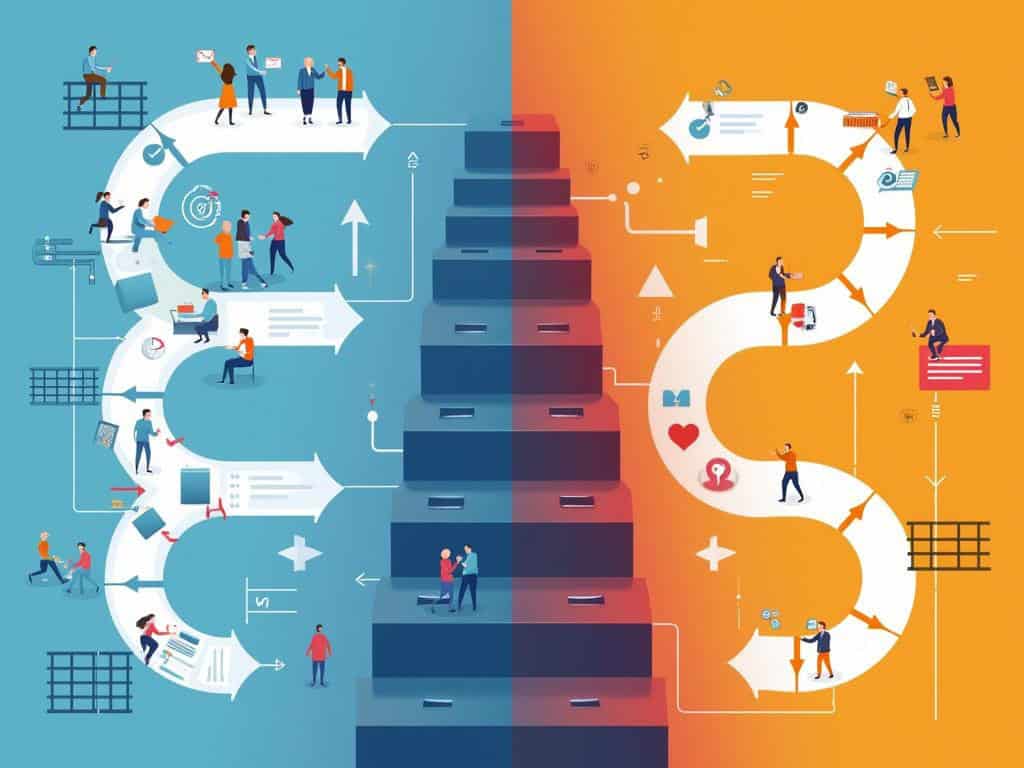
Agile vs. Waterfall Project Management
Agile project management and waterfall project management offer two distinct approaches to handling projects, each with specific methodologies and strategic implications. Waterfall follows a sequential process with defined stages, while agile uses iterative development, allowing teams to adapt to changing requirements and deliver value in increments.
Key Takeaways:
- Waterfall achieves a 13% success rate, compared to agile’s 42% success rate
- Agile methodology breaks projects into shorter sprints, enabling rapid adaptation
- Waterfall is best suited for projects with stable, well-defined requirements
- Agile emphasizes continuous stakeholder feedback and collaboration
- The choice between methodologies depends on project complexity, team expertise, and organizational goals
Project management approaches can significantly impact your team’s success. According to Project Management Institute research, agile methods deliver nearly triple the success rate of traditional waterfall approaches. This stark difference comes from how each methodology structures work and responds to change.
The structure of your project directly affects how you’ll handle unexpected challenges. Waterfall creates a straightforward path that works well for predictable projects with clear requirements. For more dynamic situations, agile provides the flexibility to adjust course through regular sprint cycles and feedback sessions.
Your team composition and skills also play a crucial role in methodology selection. Some organizations benefit from a hybrid approach that combines elements from both systems, particularly during transformation periods when teams are developing new capabilities. This balanced strategy can provide structure while building adaptability.
“In the battle of project management methodologies, agile emerges as a dynamic champion, boasting a remarkable 42% success rate by embracing adaptability and iterative progress, while waterfall lags behind at 13%, confined to its rigid, linear framework. Ultimately, the best approach hinges on the project’s complexity and the need for continuous collaboration, underscoring the importance of aligning strategy with organizational goals.”
The Waterfall Methodology: A Structured Approach
Waterfall project management follows a linear, sequential process where each phase must be completed before moving to the next. This methodology provides a clear structure with distinct phases: requirements gathering, design, implementation, testing, and deployment. You’ll find this approach particularly beneficial when working with fixed, well-defined requirements that are unlikely to change significantly during the project lifecycle.
The structured nature of waterfall project management makes it ideal for industries requiring extensive documentation and regulatory compliance. Construction, manufacturing, and healthcare sectors often rely on this methodology because it provides comprehensive documentation at each stage and follows a predictable critical path. When conducting post-implementation reviews, waterfall projects typically have extensive documentation to reference.
Waterfall project management and agile project management differ fundamentally in how they handle changes and stakeholder involvement. Consider these key characteristics of the waterfall approach:
- Thorough upfront planning with detailed documentation
- Sequential phase completion with formal sign-offs
- Clear milestones and deliverables at each stage
- Limited flexibility for requirement changes once the project begins
- Comprehensive testing phase before final deployment
According to the Standish Group, waterfall projects have a success rate of approximately 13%, significantly lower than agile methodologies. This difference highlights the importance of selecting the right approach based on your project needs and organizational environment. For projects with strict regulatory requirements or fixed specifications, waterfall provides the structure and documentation needed for compliance and project assurance.
When to Use Waterfall Methodology
You should consider waterfall project management when your project meets these criteria:
- Requirements are well-understood and unlikely to change
- The project scope is clearly defined from the outset
- Stakeholders need predictable timelines and budgets
- Regulatory compliance requires extensive documentation
- Team members are experienced with traditional project management approaches
| Project Characteristic | Waterfall Suitability | Agile Suitability |
|---|---|---|
| Requirement Stability | High (fixed requirements) | Low (evolving requirements) |
| Stakeholder Involvement | Primarily at beginning and end | Continuous throughout |
| Documentation Needs | Comprehensive | Minimal, focused on value |
| Risk Management | Preventive approach | Adaptive approach |
| Team Structure | Hierarchical | Self-organizing |
When managing project constraints and dependencies, waterfall provides clear visibility through its structured phases, making it easier to track progress against initial plans. However, its limited flexibility can present challenges when addressing unexpected issues that may arise during implementation.
According to the Standish Group, only 13% of waterfall projects succeed compared to higher success rates in agile methodologies, emphasizing the importance of choosing the right project management approach.
cio.com
The Agile Methodology: Flexible and Iterative
Agile project management and waterfall project management represent two distinctly different approaches to delivering projects. Agile methodology breaks projects into smaller, manageable increments called sprints, typically lasting 2-4 weeks. This iterative approach allows you to adapt quickly to changing requirements and market conditions.
Core Elements of Agile Project Management
The foundation of agile project management and waterfall project management comparison begins with understanding agile’s key principles. Agile emphasizes collaboration, adaptability, and continuous feedback throughout the development process. Your teams become cross-functional and self-organizing, taking collective responsibility for delivering value.
Here are the fundamental components that make agile methodology effective:
- Sprint Planning: Teams define work to be completed in each sprint
- Daily Stand-ups: Brief daily meetings to discuss progress and obstacles
- Sprint Reviews: Demonstrations of completed work to stakeholders
- Sprint Retrospectives: Team reflections on process improvement
- Product Backlogs: Prioritized lists of features and requirements
According to the Standish Group, agile project management delivers significantly higher success rates (42%) compared to waterfall project management (13%). This stark difference highlights why many organizations are adopting agile methodologies for their projects.
Agile works exceptionally well in dynamic industries where requirements frequently change. Software development teams particularly benefit from this approach as it enables them to deliver working products incrementally while gathering user feedback. This creates a virtuous cycle of continuous improvement.
The following table compares key aspects of both methodologies:
| Aspect | Agile Project Management | Waterfall Project Management |
|---|---|---|
| Approach | Iterative and incremental | Linear and sequential |
| Flexibility | Highly adaptable to changes | Resistant to changes after initiation |
| Customer Involvement | Continuous throughout project | Primarily at beginning and end |
| Documentation | Minimal, focused on working products | Comprehensive and detailed |
| Risk Management | Early identification through iterations | Identified in planning phase |
When implementing agile, you’ll need to establish appropriate scope management metrics to track progress and ensure project success. The iterative nature of agile project management and waterfall project management creates different measurement needs.
Agile methodology thrives in environments where innovation and rapid response to market changes are critical. By embracing this flexible approach, you can deliver value more quickly while maintaining the ability to pivot when necessary. The focus on collaboration and continuous stakeholder engagement ensures that the final product meets actual user needs rather than just fulfilling initial requirements.

Comparative Analysis: Success Rates and Performance
When examining agile project management and waterfall project management approaches, the performance metrics reveal significant differences in success rates. According to the Standish Group, agile project management achieves a success rate of 42%, while waterfall project management lags behind at just 13%. This substantial gap demonstrates why many organizations are transitioning toward more adaptive methodologies.
A PWC study further reinforces this difference, showing that agile project management delivers 28% more successful outcomes than traditional waterfall approaches. You’ll find that projects using agile methodologies experience fewer complete failures and deliver more consistent value to stakeholders. This performance gap is particularly noticeable in complex projects where requirements frequently change or evolve throughout the development lifecycle.
Key Performance Indicators Between Methodologies
You can evaluate the effectiveness of both agile project management and waterfall project management through several critical metrics. The following table summarizes the key performance differences between these methodologies:
| Performance Indicator | Agile Project Management | Waterfall Project Management |
|---|---|---|
| On-time delivery | 77% of projects | 56% of projects |
| Budget adherence | 59% within budget | 38% within budget |
| Scope flexibility | High adaptability | Limited flexibility |
| Time to market | Faster with incremental delivery | Longer with single delivery |
| Risk management | Continuous assessment | Front-loaded assessment |
| Stakeholder satisfaction | Higher through regular feedback | Variable, often assessed at end |
These metrics highlight why you might choose agile project management when flexibility and regular delivery are priorities. Agile’s iterative approach allows for continuous improvement throughout the project lifecycle, enabling teams to adapt to changing requirements while maintaining progress.
For projects with clearly defined requirements and little expected change, waterfall project management can provide the structure needed to deliver predictable results. You’ll benefit from comprehensive documentation and clear phase transitions that support stakeholder engagement at critical milestones.
When implementing either methodology, avoid common project management mistakes that can undermine success. Each approach requires specific oversight and management techniques to maximize effectiveness and ensure your team achieves optimal results.
Agile project management achieves a success rate of 42%, while waterfall project management lags behind at just 13%. This substantial gap demonstrates why many organizations are transitioning toward more adaptive methodologies.
hbr.org
Choosing the Right Methodology
When selecting between agile project management and waterfall project management, you need to understand their fundamental differences to make an informed decision. Your project’s success often hinges on choosing the methodology that best aligns with your specific needs, team structure, and organizational goals.
Waterfall project management follows a linear, sequential process with distinct phases: requirements gathering, design, implementation, testing, and deployment. This structured approach works well for projects with clearly defined requirements that aren’t likely to change. You’ll find waterfall particularly effective in industries like construction, manufacturing, and healthcare where regulatory compliance and comprehensive documentation are essential.
Agile project management, on the other hand, breaks projects into smaller increments called sprints, emphasizing flexibility, collaboration, and continuous feedback. This methodology allows you to adapt to changing requirements quickly and deliver value in shorter timeframes. Agile project management and waterfall project management differ significantly in how they handle change – while waterfall resists it, agile embraces it as an opportunity for improvement.
Key Selection Factors
Several factors should influence your choice between agile project management and waterfall project management:
- Project complexity and clarity – Waterfall works better for well-defined projects, while agile excels with evolving requirements
- Timeline flexibility – Agile accommodates changes more easily throughout the development process
- Stakeholder involvement – Agile requires consistent stakeholder engagement, while waterfall typically involves them mainly at beginning and end
- Team expertise – Consider your team’s familiarity with each methodology
- Risk tolerance – Agile distributes risk across iterations, while waterfall concentrates it toward project completion
The evidence supports agile’s growing popularity. According to the Standish Group, agile projects achieve a 42% success rate compared to just 13% for waterfall projects. A PWC study further revealed that agile projects are 28% more successful than traditional approaches.
Many organizations now implement hybrid approaches that combine elements of both agile project management and waterfall project management. This flexibility allows you to tailor project delivery frameworks to specific requirements while maintaining consistent strategic planning across your organization.
Before committing to either methodology, assess your project’s constraints and dependencies. You might find that understanding these factors leads you to a hybrid approach rather than strictly following either agile project management or waterfall project management principles.
Agile projects have a 42% success rate compared to 13% for waterfall projects.
standishgroup.com
Implementing Project Management Strategies
When it comes to executing successful projects, choosing between agile project management and waterfall project management is crucial. These methodologies offer distinct approaches to organizing work, managing teams, and delivering results. Your organization’s success often hinges on selecting and implementing the right project management framework.
Waterfall project management follows a linear, sequential process with clearly defined phases. You’ll complete each stage before moving to the next—requirements gathering, design, implementation, testing, and deployment. This structured approach works well for projects with stable, well-defined requirements where changes are minimal. Construction, manufacturing, and healthcare industries often benefit from waterfall’s comprehensive documentation and predictable progression.
Hybrid Approaches and Implementation Considerations
Many organizations find success with hybrid approaches that combine elements of agile project management and waterfall project management. These blended methodologies leverage waterfall’s structure for stable project components while using agile for areas requiring flexibility. According to the Standish Group, agile projects achieve a 42% success rate compared to waterfall’s 13%, making hybrid approaches increasingly popular.
When implementing your chosen methodology, consider these key factors:
- Team capabilities: Assess your team’s familiarity with agile project management principles or waterfall frameworks
- Project complexity: More complex projects may benefit from agile’s iterative approach
- Stakeholder expectations: Determine if stakeholders need regular deliverables (agile) or prefer comprehensive end products (waterfall)
- Regulatory requirements: Some industries require the detailed documentation waterfall provides
Your implementation strategy should include proper project communication channels and tools that support your methodology. Training is essential—especially when transitioning from traditional waterfall project management to agile methodologies. Research shows that organizations providing comprehensive training experience 28% higher success rates (PWC study).
The following table highlights key differences to consider when implementing either methodology:
| Implementation Factor | Agile Project Management | Waterfall Project Management |
|---|---|---|
| Planning approach | Iterative planning | Comprehensive upfront planning |
| Change management | Embraces change | Resists changes after planning |
| Team structure | Self-organizing teams | Hierarchical team structure |
| Delivery cadence | Frequent deliverables | Single end-product delivery |
| Risk management | Continuous assessment | Early risk response planning |
Remember that successful implementation requires organizational commitment. You’ll need to adjust your governance models, stakeholder satisfaction approaches, and reporting structures to align with your chosen methodology. Consider conducting a post-implementation audit to assess effectiveness and identify improvement opportunities.






